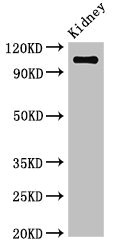CD13/Aminopeptidase-N(B-F10), CF405S conjugate, 0.1mg/mL [26628-22-8]
BNC040343
ApplicationsFlow Cytometry, Western Blot
Product group Antibodies
TargetANPEP
Overview
- SupplierBiotium
- Product NameCD13/Aminopeptidase-N(B-F10), CF405S conjugate, 0.1mg/mL
- Delivery Days Customer9
- ApplicationsFlow Cytometry, Western Blot
- CertificationResearch Use Only
- ClonalityMonoclonal
- Clone IDB-F10
- Concentration0.1 mg/ml
- ConjugateOther Conjugate
- Gene ID290
- Target nameANPEP
- Target descriptionalanyl aminopeptidase, membrane
- Target synonymsalanyl (membrane) aminopeptidase; aminopeptidase M; aminopeptidase N; AP-M; APN; AP-N; CD13; GP150; hAPN; LAP1; membrane alanyl aminopeptidase; microsomal aminopeptidase; myeloid plasma membrane glycoprotein CD13; P150; PEPN
- HostMouse
- IsotypeIgG1
- Protein IDP15144
- Protein NameAminopeptidase N
- Scientific DescriptionRecognizes an integral membrane glycoprotein of 150 kDa, identified as CD13 (also known as aminopeptidase-N). The CD13 antigen is present on most cells of myeloid origin including granulocytes, monocytes, mast cells, and GM-progenitor cells. It is also expressed by the majority of AML, CML in myeloid blast crisis, and in a smaller fraction of lymphoid leukemias. CD13 is absent from normal lymphocytes, platelets and erythrocytes. CD13 is also present on fibroblasts; endothelial cells, epithelial cells from renal proximal tubules and intestinal brush border, bone marrow stromal cells, osteoclasts, and cells lining bile duct canaliculi. CD13 is identical to aminopeptidase N (APN), a prominent membrane-bound metalloprotease present on the surface of intestinal brush border and renal tubules. CD13 plays a role in metabolism of biologically active peptides, in phagocytosis, and in bactericidal/tumoricidal activities. It also serves as a receptor for human coronaviruses (HCV). The lineage-restricted pattern of expression of CD13 within the hemopoietic compartment suggests that it may be important in myeloid cell differentiation. Primary antibodies are available purified, or with a selection of fluorescent CF® Dyes and other labels. CF® Dyes offer exceptional brightness and photostability. Note: Conjugates of blue fluorescent dyes like CF®405S and CF®405M are not recommended for detecting low abundance targets, because blue dyes have lower fluorescence and can give higher non-specific background than other dye colors.
- SourceAnimal
- Storage Instruction2°C to 8°C
- UNSPSC12352203





